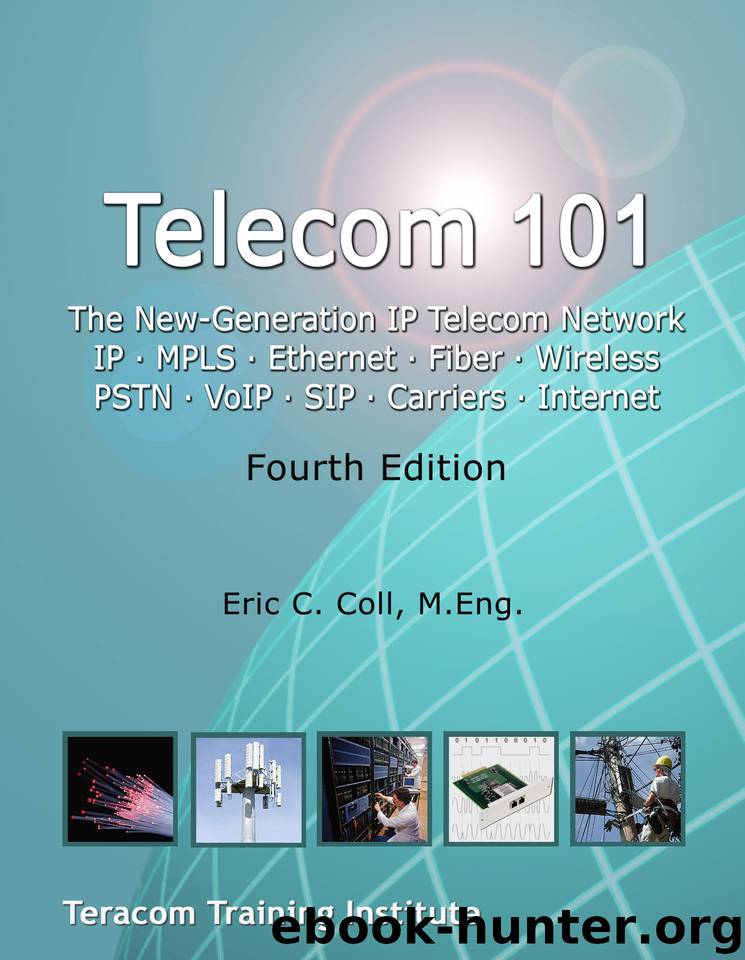Telecom 101: CTA Study Guide and High-Quality Reference Book Covering All Major Telecommunications Topics... in Plain English. by Coll Eric

Author:Coll, Eric
Language: eng
Format: epub
Publisher: Teracom Training Institute
Published: 2016-04-12T16:00:00+00:00
Figure 103. OFDM
In the simplest implementation, illustrated in Figure 103, the incoming bits are used to turn subcarriers on or off, splitting the incoming bit stream at a rate of 1 bit per subcarrier and implementing binary Amplitude Shift Keying, with one of the amplitudes zero.
In the most complex implementation, the incoming bit stream would be allocated at a rate of 6 bits per subcarrier, used to implement QAM-64 on each of the subcarriers.
The outputs of the subcarrier modulations are all added together to produce a transmittable waveform.
To allow multiple users at the same time, Orthogonal Frequency-Division Multiple Access (OFDMA) is implemented… essentially adaptively assigning specific subcarriers to particular users.
The beautiful part of OFDM (at least to Engineers) is that the modulation of each subcarrier and adding them all together is calculated in a single step with a digital signal processing operation called an Inverse Discrete Fourier Transform. At the receiver, a Discrete Fourier Transform performs the reverse process to yield the original bit stream.
This calculation is performed, and a waveform transmitted at the same frequency as the spacing of the subcarriers, which has the result of making the harmonics of all of the subcarriers cancel each other out at the receiver, hence the term orthogonal.
In the LTE standard, the subcarriers are spaced 15 kHz apart, and the output is calculated 15,000 times per second.
Prior to modulation, Forward Error Correction is implemented, adding redundancy to the bit stream so correct decisions can be made based on maximum likelihood in the presence of impairments like noise and fading.
The bit stream is also shuffled or interleaved, re-arranging the order of the bits in time so that burst errors are no longer sequential errors.
In the uplink, LTE uses a pre-coded version of OFDM called Single Carrier Frequency Division Multiple Access (SC-FDMA) to avoid needing power amplifiers, which would increase handset cost and shorten battery life.
10.8.3 3GPP Standards Committees
The 3GPP Technical Report 25.913 contains the detailed requirements specification for LTE. The system architecture, in Technical Specifications 36.300 and 36.401, is simplified to two principal network elements: evolved Network Base stations (eNBs) and Evolved Packet Cores (EPCs). eNBs communicate with EPCs, with each other and with user equipment.
The ITU defined as 4G supporting at least 1 Gb/s downloading. LTE does not meet that criteria, and so in a strict standards committee environment, LTE would be called a 3G technology.
An updated version, 3GPP release 10, called LTE-Advanced, is expected to be submitted to the IMT-Advanced standards committee, which would cause those standards committee members to declare LTE-Advanced to be a 4G standard.
Everyone else will refer to LTE as 4G from the start.
10.8.4 Qualcomm Patents
One of the reasons for the 3G standards war was the requirement to pay American company Qualcomm royalties on patents for several techniques necessary for a mobile CDMA system.
LTE is not CDMA, so those royalties are avoided… but it turns out that Qualcomm filed or has purchased many patents that underpin LTE.
Additionally, since LTE phones will have to be backwards-compatible with 3G CDMA
Download
This site does not store any files on its server. We only index and link to content provided by other sites. Please contact the content providers to delete copyright contents if any and email us, we'll remove relevant links or contents immediately.
| Automotive | Engineering |
| Transportation |
Whiskies Galore by Ian Buxton(41879)
Introduction to Aircraft Design (Cambridge Aerospace Series) by John P. Fielding(33064)
Small Unmanned Fixed-wing Aircraft Design by Andrew J. Keane Andras Sobester James P. Scanlan & András Sóbester & James P. Scanlan(32743)
Craft Beer for the Homebrewer by Michael Agnew(18140)
Turbulence by E. J. Noyes(7936)
The Complete Stick Figure Physics Tutorials by Allen Sarah(7307)
Kaplan MCAT General Chemistry Review by Kaplan(6867)
The Thirst by Nesbo Jo(6828)
Bad Blood by John Carreyrou(6552)
Modelling of Convective Heat and Mass Transfer in Rotating Flows by Igor V. Shevchuk(6391)
Learning SQL by Alan Beaulieu(6211)
Weapons of Math Destruction by Cathy O'Neil(6146)
Man-made Catastrophes and Risk Information Concealment by Dmitry Chernov & Didier Sornette(5921)
Digital Minimalism by Cal Newport;(5664)
Life 3.0: Being Human in the Age of Artificial Intelligence by Tegmark Max(5474)
iGen by Jean M. Twenge(5366)
Secrets of Antigravity Propulsion: Tesla, UFOs, and Classified Aerospace Technology by Ph.D. Paul A. Laviolette(5309)
Design of Trajectory Optimization Approach for Space Maneuver Vehicle Skip Entry Problems by Runqi Chai & Al Savvaris & Antonios Tsourdos & Senchun Chai(5011)
Pale Blue Dot by Carl Sagan(4912)
